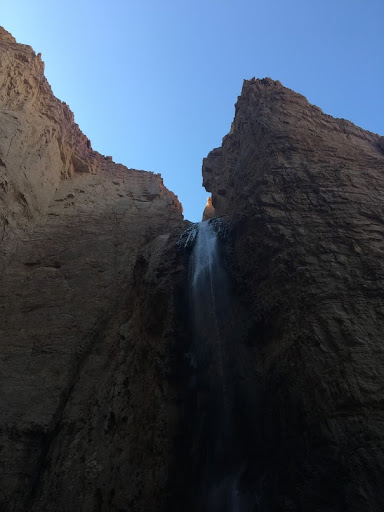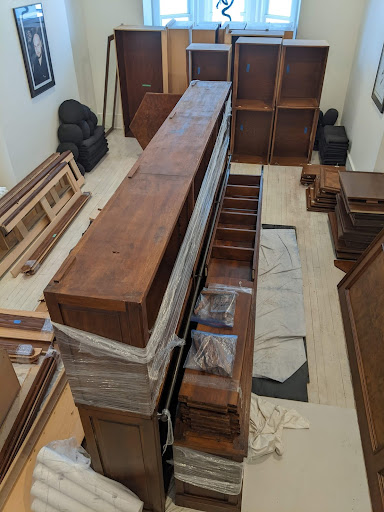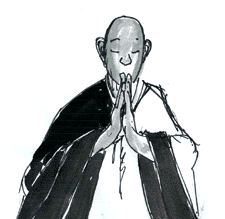
Photograph by Sarah Goul
eMirror Vol 26, No. 9

Photograph by Sarah Goul
eMirror Vol 26, No. 9
Friday, February 25th
Edited by the Practice Council
The White Wind Zen Community:
An international community practising and teaching Dogen’s Zen since 1985.
Each sound shows in its presencing, in its rising which is a falling away, in its coming which is already a going, the truth of impermanence, of ungraspability, of tracelessness, of selflessness, of intimacy.
But just as with the eye gaze and seeing, sounds become sorted according to the three klesas of passion, aggression, and stupidity. There are so many sounds that most of them are treated as background. Others are heard with layers of associations and predetermined responses. The timbre of a voice or a tone of voice reminds you of your mother and so you take an instant dislike to the person or feel irritated or defensive or dependent or fond or whatever. The sound of the voice itself is not heard, or at least is not allowed to stand forth. And this is unfortunate because quite often, the most interesting thing about someone speaking is not what they say or the tone of their voice but the actual sound of it.
We don’t hear the rustle of the sleeve as the hand reaches for the cup. We don’t hear the sound of the cup as it we put it down on the table. Even when we listen to music, we might be simply using the music as a background on which to project our feeling-tones and sense of identity.
I really do not understand the attraction in this. Music which is suited for this purpose tends to be so structurally uninteresting that it depends upon the most obvious phrasing and instrumentation, often with words which depict a set of the most unarticulated and unnuanced emotionality that are more or less sung or shouted or mumbled. Rather than development, the musical phrases depend more upon repetition and reiteration than an exploration of the relationships between the phrases and their variations.
-Ven Anzan Hoshin roshi, continuing Class Three: The Sea of Sounds" in the series "Zen Arts: The Flowering of the Senses", October 1999 Daruma-ki O-sesshin, Dainen-ji.
Fusatsu: March 2nd and 16th
March Two-day Sesshin:
The March two-day sesshin will begin at 8:00 p.m. on March 11th and will end at 6:00 p.m. on Sunday the 13th.
Keizan Ki
March 21st is the memorial for Keizan Jokin zenji.
Hermitage:
The Roshi is currently in an extended period of "self-isolation" due to underlying health issues until the COVID-19 situation clarifies.
Beginning Instruction in Zen Practice:
For information concerning our Long-distance Training Program, please visit this Web Page: https://wwzc.org/long-distance-training-program
Rev. Chiso anagarika sat her weekly semi-retreat on Tuesday, February 22nd at her home in the Berkshires. Tarik Kaya sat a half-day retreat on Saturday, February 20th at his home in Ottawa, Ontario.
If you would like to sit a retreat at home please follow the schedule outlined in this page: https://wwzc.org/retreat-schedule-public-students. After your retreat, please send an email to schedule@wwzc.org to confirm that you sat a retreat and include the duration and location.
Work has recently begun on converting the empty east wing rooms at Dainen-ji. The first part of the project is to build the Shuryo (a monastery Library and Study Hall) in the main section of the space. As you will have read about previously in the eMirror, Saigyo ino travelled to Toronto recently to dismantle and bring back a large second-hand oak and burled walnut library, which will be built into the new space.
As the dismantled library is currently being housed in the Zendo (one of our two practice rooms), it is a priority to get this room completed so that the Zendo is functional again for when the monastery opens to students and to the public.

Dismantled library currently in the Zendo
Saigyo ino has made arrangements to take two months of unpaid leave from his work to do the majority of the construction and, with as much help as possible from students, hopes to complete the work by May.
Although a great deal of money will be saved by having the Ino and students work on this project, funds are still required for the purchase of materials and to pay an electrician for the electrical work needed. If you are able to donate towards this project your help will be very much appreciated. All donations will be tax deductible. And if you would like to assist with the work, please contact the Ino at saigyo dot cross at wwzc dot org to discuss your schedule.
Thank you very much.
Here are a couple of renderings by the Ino which gives an idea of what the Shuryo will look like when completed.


Saturday, February 26th to Saturday, March 5th
Saturday, February 26th: "Drawn In, Moving Forth": Zen Master Anzan Hoshin's Commentaries on Eihei Dogen zenji's “Bendowa: A Talk on Exerting the Way”: "What Is The Same For Each of Us" (22 of 28)
Sunday, February 27th: SAkN ”Root Cycle Three” by Ven. Anzan Hoshin roshi: “Surrender into Radiance” (teisho 7 of 8)
Monday, February 28th: “Every Breath You Take” by Ven. Shikai Zuiko o-sensei: “Seeing People Obsessed With Pleasure" (Dharma Talk 78)
Thursday, March 3rd: “Splat” by Ven. Jinmyo Renge sensei
Saturday, March 5th: "Drawn In, Moving Forth": Zen Master Anzan Hoshin's Commentaries on Eihei Dogen zenji's “Bendowa: A Talk on Exerting the Way”: "No Wordly Things" (23 of 28)
Associate and general students should continue to follow the recorded Teachings schedule for the sitting you were attending at the monastery, and listen to that during your home practice.
You can access the online Recorded Teachings Library at wwzc.org/recorded-teachings-schedule.
You can also use the streaming site at app.wwzc.org to live stream recordings from the online Library. If you have forgotten your password or need assistance with accessing the recorded Teachings, please email schedule@wwzc.org.
Please note that teisho should be listened to in the correct order and with none missed out as themes, metaphors, questions raised and answered evolve in spirals throughout the series.
While most of the online Recorded Teachings library is password-protected and only accessible to students of the Lineage of Zen Master Anzan Hoshin, a small selection of MP3 recordings of teisho are accessible to the public at wwzc.org/recorded-teachings Additional recordings will be uploaded periodically. MP3 recordings of four recorded teisho by Ven. Anzan Hoshin roshi are currently available:
Dharma Position https://wwzc.org/dharma-position
Eyes See, Ears Hear https://wwzc.org/eyes-see-ears-hear
Embarrassment https://wwzc.org/embarrassment
Ven. Anzan Hoshin roshi's reading of his translation of Eihei Dogen zenji's “Bendowa: A Talk on Exerting the Way”: https://wwzc.org/bendowa-talk-exerting-way

Photograph of Ven. Anzan Hoshin roshi at Daijozan, mid-1980s,
by Ven. Shikai Zuiko sensei
Ven. Anzan Hoshin roshi has recently completed translation work on some shorter texts by Eihei Dogen zenji from the Shobogenzo. The work on these particular texts is based upon the literal translations that he worked on with Joshu Dainen roshi at Hakukaze-ji around 1977-78 followed by many years of putting them down, picking them up, and polishing. Naturally, more essential texts such as Uji, Genjokoan, Shinjin Gakudo and some 40 others were completed first and have been given extensive commentaries by the Roshi. This batch of texts includes Baike: Plum Blossoms, Ryugin: Howling Dragon, and Udonge: The Udumbara Blossoming and many others are nearing completion. Annotation details and successfully conveying them across various document formats are the issue at this point.
Work on Bussho: Buddha Nature, a very long and nuanced text by Dogen zenji, is ongoing.
Roshi is also finishing an update to the Saijo Shingi: The Deportment of Radiance, our manual of monastic training standards which is a supplement to the ancient Eihei Shingi and Keizan Shingi.
Begun by Ven. Shikai Zuiko o-sensei
Finished by Rev. Fushin Comeau shramon following her death

Continuing on with “Painted Cakes: A Zen Dictionary,” a limited edition text written by Anzan Hoshin roshi in the 1980s and last revised in 1994.
Sumeru (J); Meru (S): A mythological mountain which encompasses the universe and represents the core of all world systems, of all experiences.
Posted February 25th, 2021. New entries are posted every two weeks.

Dogen zenji taught in the Tenzo kyokun: Instructions for the Tenzo (https://wwzc.org/dharma-text/tenzo-kyokun-instructions-tenzo) that the work of preparing and serving meals is "a matter for realized monks who have the mind of the Way or by senior disciples who have roused the Way-seeking mind." In alignment with this, part of Zen Master Anzan Hoshin's samu for the Community involves personally overseeing the activities of the ancient office of tenzo. Ven. Jinmyo Renge sensei serves as tenzo and Mishin godo and Saigyo ino offer assistance as tenzo-anja. The following meals were prepared during the week of O-sesshin:
Monday Yakuseki:
Lundberg Farms short-grain brown rice with butter and peas; Lentil soup (blended cooked black lentils, olive oil, onions, carrots, celery, garlic, pepper, chili flakes, oregano, thyme, tomato paste, red wine, tomatoes, vegetable stock, balsamic vinegar and a drop of cream); salad of Romaine lettuce, leaf lettuce and iceberg lettuce, radishes, chopped celery, chopped tomatoes, radicchio, thinly sliced red onion, cucumbers; dressing for salad: peanut butter, unseasoned rice vinegar, lime juice, shoyu, honey, garlic, ginger, salt, Korean pepper flakes and chopped coriander stems.
Tuesday Yakuseki:
Crusty rolls with butter; choice of vegetarian bean soup or chicken stew (the base for both was the same: chopped celery, diced carrots, minced garlic, diced Spanish onion, chopped mushrooms, diced potato, pearled barley, navy beans, vegetable stock, chopped fresh parsley, thyme, oregano, basil, lots of black pepper, cayenne, a little apple cider vinegar). One pot was set aside for vegetarians. For the chicken stew, seasoned chopped chicken thighs were dusted with flour and seared and then added to a second pot of the base; served with coleslaw (green cabbage, carrots, thinly sliced onion, horseradish, lime juice, mayonnaise, salt and pepper.
Thursday Yakuseki:
Lundberg Farms short-grain brown rice; tofu and shitake mushrooms with caramalized chopped onion and green cabbage in vegetarian oyster sauce, garnished with roasted peanuts and chopped scallions (the sauce was made from minced garlic, slivered ginger, vegetarian oyster sauce, shoyu, shitake soaking liquid, shitake granules, sambal oelek); monastery-made baechu kimchi.

If you would like to thank someone for a contribution they have made, please feel free to send an email to Jinmyo osho at rengezo at Gmail dot com, but be sure to type "eMirror" in the subject line.
From Jinmyo sensei:
Thank you to Saigyo ino for making arrangements to take an unpaid two month leave from his day job in order to work on constructing the new Shuryo. Thank you to Matt Arnold, owner of KJP Select Hardwoods for making this possible. Thank you to Fushin shramon for snow clearance and for tackling a thick layer of ice on the steps to the front porch following this week’s freezing rain.
From Mishin godo:
Thank you to Saigyo ino for organizing the purchase of a new pump for the fish tank on the third floor. Thank you to Fushin shramon for installing a new doorbell system that we are trying out to replace the twenty-year-old custom doorbell system that stopped working.
From David Gallant:
Thank you to Jinmyo sensei for leading the Nehan O-sesshin and for the regular dokusan; to Mishin godo for the many hours of treasurer work she completes each year; to Saigyo ino for purchasing a new fish tank pump this week and for planning and organizing the renovation work needed in the east wing on the ground floor.
From Sarah Goul:
Thank you to Roshi for “The Bodymind of the Way: Zen Teachings on the Shinjin Gakudo of Dogen zenji, Studying the Mystery” teisho, and for accepting me as a General Student. Thank you to Sensei for “Remembering Reality: comments on the Gokan-no-ji”, and for acting as a character reference for my security clearance. Thank you to Godo and Ino for routine fun and useful practice interviews and for recent correspondence about sho and jubon.
From Julien Jefferson:
Thank you to Anzan Hoshin roshi for translating and making available the Vimalakirti Nirdesa sutra. The clarity and thoroughness of each chapter's content blows me away. Thank you to Jinmyo Renge sensei for detailed explanations of the Ten Proclamations in her presentation of The Touchstone series. Thank you to Saigyo ino for instruction in chanting practice.
From the Office of the Treasurer:
Thank you to Jinmyo sensei for a donation to cover the costs for removing the existing cedar hedge, purchasing yew trees and digging a trench for the new hedge in the front garden.
|